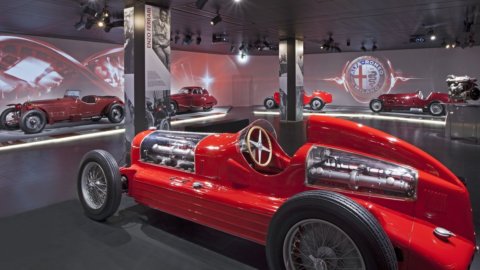Thirty years ago, in January 1987, Fiat acquired the Alfa Romeo company from the state holdings, with its two historical realities, Alfa of Arese and AlfaSud of Pomigliano d'Arco. While the workers and the union of Pomigliano welcomed the transition (as the secretary of the Neapolitan union said at the time, taking up an old popular saying "either Franza or Spain provided that they are great"), trade union opposition to the dreaded "approval" was radicalized in Arese Fiat in factory union relations, an opposition that in a few years would have led to the gradual shutdown of the plant, confirming the thesis of those who believe that one of the main causes of the disappearance of large industry in our country was precisely the union itself.
At Alfa in Arese, as in the other large factories in Milan, Magneti Marelli, OM, Sit-Siemens or Pirelli, from the seventies to the early eighties, not a year goes by without a dispute union with the relative forms and doses of conflict: pickets, internal marches, violence against leaders. A hell that for a long time will be underestimated or not perceived externally by public opinion and by political and social forces.
For all this time, conflict and antagonism will be the values on which trade unionists will inspire themselves, the "strike lords" as they were defined by an illustrious journalist. The trade union representation system will be based on the principles of direct democracy with the delegates, gathered in the "works council", elected by the workers of their own homogeneous group with non-formalized and very approximate procedures (the most widespread practice was to pass on which to write the name to be elected): the official union then proceeded to give them legal coverage (company union representatives or members of the provincial executives) to be able to benefit from the paid leave provided for by the Workers' Statute and by the National Contract for the category.
At the time of the transfer to Fiat, in Arese about a thousand workers with the "cover" of delegates, out of a total workforce of !8.000 workers, could benefit from paid union leave. While the workers' struggles escalated and the strikes multiplied, another drama took shape in Arese, the most serious of all, the terrorism of the Red Brigades with arson attacks in the painting and bodywork departments as well as the kneeling and kidnapping of managers: only in 1983 the armed column of the Alfa was eradicated.
The exasperated internal conflict and a very low level of productivity (35/40 percentage points less than the European standard), in a structural situation of dimensions and volumes insufficient to support international competitiveness, led the Alfa Romeo company, over the years, to a series of negative budgets continuously covered by the State. At that time it was customary to say that every Alfa produced cost the taxpayer over one and a half million lire.
To avoid the definitive collapse, Finmeccanica, at the time IRI's holding company for the mechanical sector, decided in 1986 to privatize its subsidiary Alfa Romeo, whose losses during the year now amounted to around 18% of turnover. The American Ford stepped forward, interested in strengthening its position on the Italian market, also with a production plant, which in those years was the second largest European car market, taking over Alfa's 7 percent share and simultaneously launching a challenge to Fiat, the national market leader with over 60 percent of the share, which not later than a year earlier had attempted to acquire the European branch of Ford itself.
The Ford plan, supported by the left and by the Milanese trade unions, envisaged only taking over the Arese plant, having not expressed interest in the Pomigliano plant, with no more products and over 4.000 workers suspended on zero hours and indefinitely. It is in the face of the presentation of the Ford plan that a series of pressures begins from the Roman trade union, from representatives of the Turin PCI, from Campania's Christian Democrats so that Fiat also presents an Alfa Romeo acquisition plan that safeguards the entire company complex.
In November 1986, the CIPI, having evaluated the Fiat proposal, approved, in the interest of the national economy, the transfer to Fiat of the entire corporate complex belonging to Alfa Romeo, i.e., in addition to the car plants of Arese and Pomigliano d 'Arco, also the former Arna of Avellino, the Arveco company of commercial vehicles also in Pomigliano, and the components company of Spica of Livorno and Merisinter of Arzano in the province of Naples.
After a laborious negotiation, in May 1987 Fiat signed a national trade union agreement based on the logic of exchange: the company undertook, with the implementation of an industrial plan of consolidation and relaunch, to eliminate layoffs in the former Alfa plants and reoccupy suspended personnel, while the national trade union gives its consent to the definition of standards which make it possible to achieve a level of productivity in line with those of the other European automotive industries, as well as a regulation of trade union rights and company relations similar to that in force in the other Fiat plants.
The trade union agreement is submitted to workers' scrutiny through a referendum: the workers of Pomigliano and of the other acquired companies approve it with a large majority, while the workers of Arese reject it, albeit by a narrow margin. The result of Arese will strengthen the attitude contrary to the national agreement of the Milanese union, perched in the defense of the "different way of making cars" through the production groups, which instead had represented one of the factors of the productivity gap.
In fact, for the most part the productivity differentials connected to work performance were attributable to the organization of work, according to which the applied work times were not those determined by a scientific methodology, but those that were in fact accepted by the workers in the production group: in this way the production group with the lowest productivity conditioned the amount of work of the other groups downwards, creating the effect of the slow convoy which determines the speed of the train.
The conflicting attitude of the Arese trade union therefore remains identical with respect to the past. The strikes against the application of the national agreement will continue, with the related corollaries of internal marches and invasion of offices. The news will also record moments of tension, which see union "delegates" as protagonists, to which the company responds with some disciplinary dismissals which will trigger a very intricate legal dispute, resolved only after a few years by the Supreme Court with the confirmation of the dismissals themselves.
On the high road of union confrontation, the opposing union will opt for that of self-defense and recourse to the judiciary, with a behavior that can be summarized, concisely, as follows: when I don't accept the rules of the game, I get right by myself; if the company sanctions me, I appeal to the magistrate; if the magistrate blames me, he is enslaved to Fiat; if the magistrate agrees with me it is an act of justice; if the magistrates of the next level blame me, then they express a "political" judgement.
Finally, the last clash between the PCI and Fiat also took place in Arese. The relations of the PCI with Fiat, from the second post-war period up to its dissolution, have always been characterized by more or less long periods of harsh confrontation and confrontation: just think of the isolation of communist activists in the so-called "red star workshops" of the 50s, the trial for "political" filings in the early 70s or the support given in the 35-day dispute in autumn 80 to those who advocated the occupation of Mirafiori.
The arrival of Fiat in Arese undermines the role of the representatives of the party section in the factory, accustomed, in the previous state management, to dialogue "politically" with the corporate structure. At the end of December 1988, with unprecedented violence (equal only to that launched by Fiom over twenty years later), the PCI, in its workerist wing, launched an attack on Fiat, accused of alleged violations of trade union freedoms and discrimination against Alpha of Arese.
The Communist Party, starting from some cases which subsequently proved to be unfounded (including one concerning the secretary of the factory section) but proposed to public opinion through the mass media (37 articles in 20 days in Unita and an entire episode of Samarcanda on RAI TV), orchestrates a denunciation campaign against the company accusing it of anti-union behaviour. The specific charge was that of discriminating against union members in managing the meritocracy and of soliciting resignations from the union by offering wage increases.
The data that emerged from the ministerial inspection proved the opposite and the press campaign ended when the Minister of Labor declared that there was no strategic plan of anti-unionism on the part of the company. This complicated political-trade union scenario also convinced Fiat to desist from the project of concentrating the production of the large cars of its brands (Alfa 164, Lancia Thema and Fiat Croma) in Arese.
Production of end-of-series models (such as the Y10) or niche models (such as the natural gas Multipla) was destined for Arese until the early 2000s when all types of production ceased. Today on the industrial area of what was once one of the largest Italian factories stands one of the major shopping centers in Europe.





